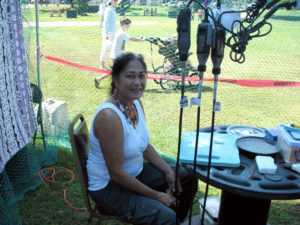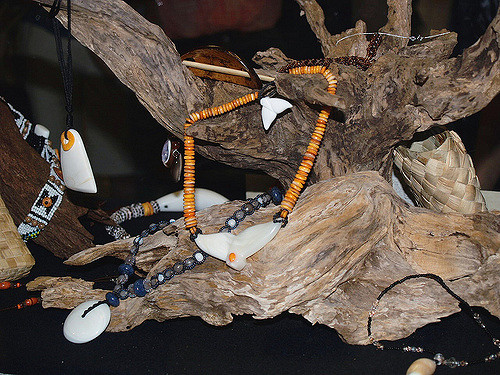Ancient Chamorros donned various styles of necklaces called ålas and salape that were made of seashells and tortoiseshell. As is common throughout much of Oceania, these forms of body adornment also served as currency and were often indicative of wealth and prestige. The arrival of Catholic missionaries from Spain in 1668 and the conversion of Chamorros to Christianity shortly thereafter saw an introduction of more Western forms of clothing and jewellery to the Marianas. The traditional forms of body adornment, made from seashells and tortoise shell, were soon replaced by rosaries worn as necklaces and a new design of jewellery. Gold and silversmiths established a specialized niche within the local population and the skills were passed down through the generations.
There has been a resurgence in traditional Chamorro jewellery making in the last decade. It is increasingly common to see men and women wearing carved shells in the shapes worn by their ancestors or symbolic of ancient Chamorro times. Men don clamshell pendants in the shapes of crescents, or sinahi; fishhooks and latte, which were stone pillars used as house supports for ancient Chamorros homes; while women more often prefer the usually orange-colored Spondylus disc-shaped pendants.

Several local artists specialize in the creation of these unique forms of jewellery. Some of the more well known of these artists are Jill Benavente, John B. Castro, James M. Cruz, George Francisco, Joe Guerrero, Frank Perez, Greg Pangelinan, Johnny “Cake” Siguenza, and Ben Del Rosario (known as Sinahi).
The materials most commonly used by these artists include clamshell, Spondylus shells, bone, and ifit (ifil) wood. All of the artists create their pieces by hand.
Jill Benavente began carving in the mid-1990s. She owns and operates the Guinahan Chamoru shop in Mangilao that serves as a cooperative for a number of local artists. She takes pride in her work and has taken several female apprentices to teach them how to create her unique style of necklaces.

George Francisco started to create his necklaces just over a year ago. He uses a variety of materials for his pendants including clam and abalone shells and whalebone. In addition to the commonly seen fishhooks and sinahi, he creates a variety of forms such as intertwined and twisted fishhooks and at times will carve the outline into different shapes, such as that of a dolphin, onto the surface of the latte pendant.
Joe Guerrero, who began carving in 1994, prefers to use ifil wood, clamshell, fish bone, and Spondylus shells for his pieces. Guerrero takes pride in personalizing each work for his clients so that their personal history plays a role in determining the final form of the piece.
Frank Perez and Greg Pangelinan formed Chamorro Crafters. Pangelinan began carving at the age of sixteen, more than forty years ago. Perez joined Pangelinan after retirement six years ago and, together, they carve a variety of pendants out of wood, bone, shells, stone, and basalt. They are also practicing blacksmiths. Like Benavente, they have apprentices under their tutelage to ensure that the skills of carving and blacksmithing continue.
Like the Chamorro artists, artists from the neighboring Micronesian islands also create forms of jewellery that consist of the shells and other materials found in the natural environment.
Although previously these pendants and necklaces were viewed as indicators of high rank, local residents now create and wear these pendants as an expression of respect and pride associated with the ancient Chamorros and their traditional ways of life.
Further reading
Cunningham, Lawrence J. and Janice J. Beaty. A History of Guam. Honolulu: The Bess Press, 2001.
Feldman, Jerome and Donald H. Rubinstein. The Art of Micronesia: The University of Hawaii Art Gallery. Essays by Jerome Feldman and Donald H. Rubinstein. Honolulu: University of Hawaii Department of Art and Partners, c.1986.
Flores, Judy. “Art and Identity in the Mariana Islands: Issues of Reconstructing an Ancient Past.” PhD Thesis, Sainsbury Research Unit, University of East Anglia, Norwich, UK, 1999. Manuscripts are available at the University of Guam Richard F. Taitano Micronesian Area Research Center and at Sainsbury Research Unit, University of East Anglia, Norwich, UK.
Freycinet, Louis Claude de Saulses de. An Account of the Corvette L’Uraine’s Sojourn at the Mariana Islands, 1819. Translated by Glynn Barratt. Saipan, CNMI: Commonwealth of the Northern Mariana Islands Division of Historic Preservation and the University of Guam Richard F. Taitano Micronesian Area Research Center, 2003.
Kihleng, Kimberlee S. and Nancy P. Pacheco, eds. Art and Culture of Micronesian Women: Catalog of Interpretive Exhibition Presented by Isla Center for the Arts and the Women and Gender Studies Program at the University of Guam, April 13 through May 22, 2000. Mangilao, GU: Isla Center for the Arts and Women & Gender Studies Program, University of Guam, 2000.





